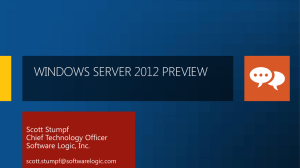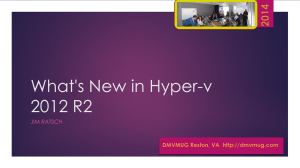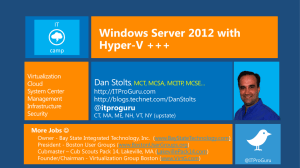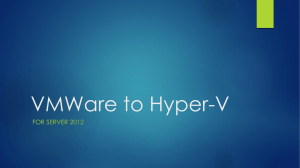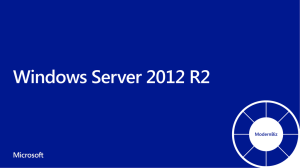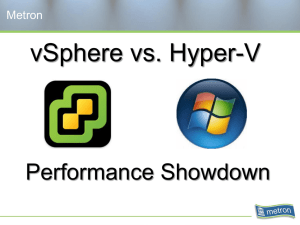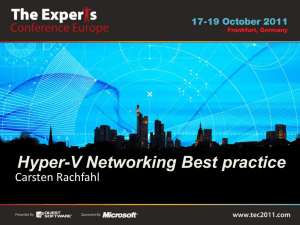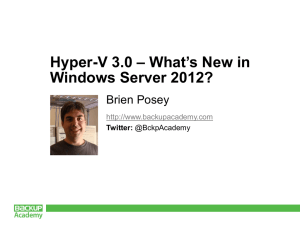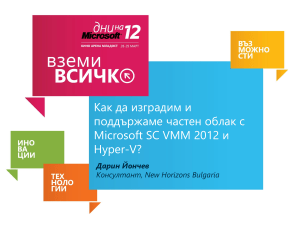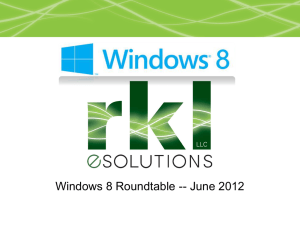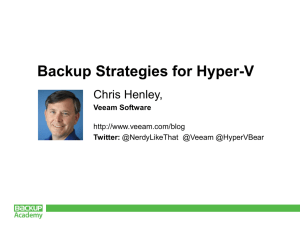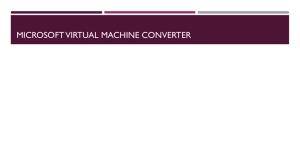L300 Windows Server 2012 R2 Server Virtualization
advertisement
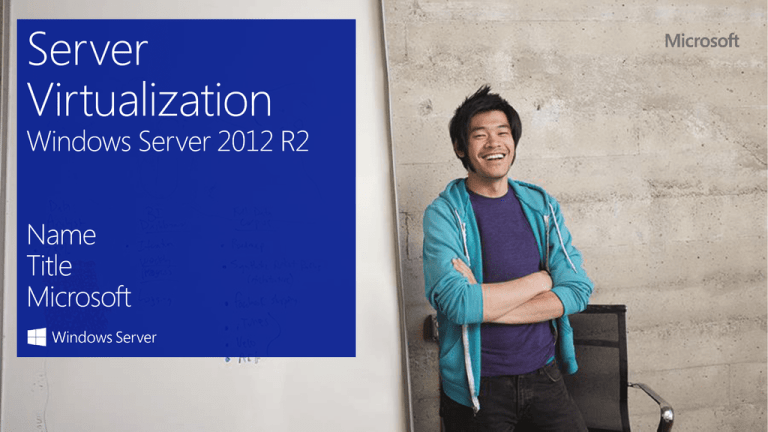
Flat or shrinking IT budgets even as business expectations increase. “Keeping the lights on” mandate reduces agility to address app owners’ needs. Efficient datacenter operations across entire customer base. Need to offer differentiated services to customers. Enterpriseclass Simple and cost-effective Complexities due to diverse datacenter infrastructure. End user pressure to enable access to corporate information from a variety of devices. Application focused User centric New levels of performance and cross-platform support IT demands Support for demanding, critical business workloads Increased flexibility to move resources and workloads Leverage existing crossplatform investments Windows Server 2012 R2 delivers Enterprise-class scale and performance. Virtual machine mobility. First-class citizen guest support for Linux. Run the most demanding applications with the highest levels of performance & scalability Ensure optimal resource availability for key applications & workloads Provide guaranteed levels of service for the key applications and workloads Take advantage of hardware innovations, while still using existing hardware to maximum advantage Massive scalability for the most demanding workloads Hosts • Support for up to 320 logical processors & 4TB physical memory per host • Support for up to 1,024 virtual machines per host Clusters • Support for up to 64 physical nodes & 8,000 virtual machines per cluster Virtual Machines • Support for up to 64 virtual processors and 1TB memory per VM In Guest Non-Uniform Memory Access • Projects NUMA topology onto a virtual machine • Allows guest operating systems and applications to make intelligent NUMA decisions • Aligns guest NUMA nodes with host resources • Workloads such as SQL Server 2012, or IIS 8.0 can take advantage of Guest NUMA High levels of performance for key Microsoft workloads SQL Server 2012 • 64 vCPU support drove 6x performance increase over previous version of Hyper-V • 6.3% overhead compared with physical Exchange 2013 • Virtualized 48,000 simulated users on a single Hyper-V host across 12 VMs, with low response times SharePoint 2013 • Scaled to over 2 million heavy users at 1% concurrency, across 5 VMs on a single Hyper-V host SharePoint Workload Hyper-V Virtual CPUScalability Scalabilityon Windows Server with Hyper-V with OLTP2012 Workloads VHDX & Support for Advanced Format Drives Capabilities • Improved performance of virtual hard disks on 512e disks • Ability to host virtual hard disks on native 4 KB disks Benefits • Reduces impact of 512e disks on virtual hard disk stack • Workloads complete more quickly VHDX Provides Increased Scale, Protection & Alignment Features • Storage capacity up to 64 TBs • Corruption protection during power failures Block Allocation Table (BAT) User data blocks Sector bitmap blocks • Optimal structure alignment for large-sector disks Benefits • Increases storage capacity • Protects data • Helps to ensure quality performance on large-sector disks User metadata Metadata table File metadata Online VHDX Resize provides VM storage flexibility Expand Virtual SCSI Disks 1. Grow VHD & VHDX files whilst attached to a running virtual machine 2. Then expand volume within the guest Shrink Virtual SCSI Disks 1. Reduce volume size inside the guest 2. Shrink the size of the VHD or VHDX file whilst the VM is running Token-based data transfer within the storage array Benefits • Rapid virtual machine provisioning and migration • Faster transfers on large files • Minimized latency • Maximized array throughput • Less CPU and network use • Performance not limited by network throughput or server use • Improved datacenter capacity and scale Access Fibre Channel SAN data from a virtual machine • Unmediated access to a storage area network (SAN) • Hardware-based I/O path to virtual hard disk stack • N_Port ID Virtualization (NPIV) support • Single Hyper-V host connected to different SANs • Up to four Virtual Fibre Channel adapters on a virtual machine • Multipath I/O (MPIO) functionality • Supports Live migration Provides Near-Line Rate to a VM on Existing Hardware vNIC • vRSS makes it possible to virtualize traditionally network intensive physical workloads • Extends the RSS functionality built into Windows Server 2012 Node 2 Node 0 Node 1 0 1 2 3 0 1 2 3 Node 3 • Maximizes resource utilization by spreading VM traffic across multiple virtual processors • Helps virtualized systems reach higher speeds with 40 Gbps and 100 Gbps NICs • Requires no hardware upgrade and works with any NICs that support RSS Incoming packets Increased efficiency of network processing on Hyper-V hosts Without VMQ • Hyper-V Virtual Switch is responsible for routing & sorting packets for VMs • This leads to increased CPU processing, all focused on CPU0 With VMQ • Physical NIC creates virtual network queues for each VM to reduce host CPU With Dynamic VMQ • Processor cores dynamically allocated for a better spread of network traffic processing Integrated with NIC hardware for increased performance • Standard that allows PCI Express devices to be shared by multiple VMs Virtual Machine VM Network Stack Synthetic NIC • More direct hardware path for I/O • Reduces network latency, CPU utilization for processing traffic and increases throughput • SR-IOV capable physical NICs contain virtual functions that are securely mapped to VM • This bypasses the Hyper-V Extensible Switch • Full support for Live Migration Hyper-V Extensible Switch Virtual Function Achieve higher levels of density for your Hyper-V hosts Windows Server 2008 R2 SP1 • Introduced Dynamic Memory to enable reallocation of memory automatically between running virtual machines Maximum memory Maximum memory Minimum memory Enhanced in Windows Server 2012 & R2 • Minimum & Startup Memory • Smart Paging • Memory Ballooning • Runtime Configuration Hyper-V Physical memory pool Utilize disk as additional, temporary memory Maximum memory Maximum memory Hyper-V Smart Paging • Reliable way to keep a VM running when no physical memory is available Minimum memory Minimum memory • Performance will be degraded as disk is much slower than memory Used in the following situations: Hyper-V • VM restart • No physical memory is available • No memory can be reclaimed from other virtual machines on that host Physical memory pool Maximum memory Minimum memory Features • Uses resource pools • Compatible with all Hyper-V operations • Unaffected by virtual machine movement • Uses Network Metering Port ACLs Benefits of Resource Metering • Easier to track virtual machine use • Can be used to aggregate data for multiple virtual machines • Can be used to build accurate lookback and chargeback solutions • Easier to obtain resource use data 0 Achieve desired levels of networking performance Bandwidth Management Normal priority High priority Bronze tenant Critical Silver tenant Gold tenant • Establishes a bandwidth floor • Assigns specified bandwidth for each type of traffic • Helps to ensure fair sharing during congestion • Can exceed quota with no congestion Hyper-V Extensible Switch Hyper-V Extensible Switch Gold tenant Gold tenant Gold tenant 2 Mechanisms • Enhanced packet scheduler (software) • Network adapter with DCB support (hardware) Hyper-V Extensible Switch NIC Teaming Control allocation of Storage IOPS between VM Disks • Allows an administrator to specify a maximum IOPS cap • Takes into account incoming & outgoing IOPS • Configurable on a VHDX by VHDX basis for granular control whilst VM is running • Prevents VMs from consuming all of the available I/O bandwidth to the underlying physical resource • Supports Dynamic, Fixed & Differencing Ensure workloads have the highest levels of security & isolation with granular control capabilities Integrate with new and existing software & hardware investments Meet compliancy requirements with through encryption Provide in-box hooks for in-house extensibility and customization Layer-2 Network Switch for Virtual Machine Connectivity Extensible Switch • Virtual Ethernet switch that runs in the management OS of the host • Exists on Windows Server Hyper-V, and Windows Client Hyper-V • Managed programmatically • Extensible by partners and customers • Virtual machines connect to the extensible switch with their virtual network adaptor • Can bind to a physical NIC or team • Bypassed by SR-IOV Layer-2 Network Switch for Virtual Machine Connectivity Granular In-box Capabilities • ARP/ND Poisoning (spoofing) protection • DHCP Guard protection • Virtual Port ACLs • Trunk Mode to VMs • Network Traffic Monitoring • Isolated (Private) VLAN (PVLANs) • PowerShell & WMI Interfaces for extensibility Segregate traffic within VLANs Enables • Isolation of virtual machines from other virtual machines even within the same VLAN • Creation of community groups of virtual machines that can exchange data packets 3 Port Types • Isolated • Community • Promiscuous Build Extensions for Capturing, Filtering & Forwarding 2 Platforms for Extensions • Network Device Interface Specification (NDIS) filter drivers • Windows Filtering Platform (WFP) callout drivers Extensions • NDIS filter drivers • WFP callout drivers • Ingress filtering • Destination lookup and forwarding • Egress filtering Build Extensions for Capturing, Filtering & Forwarding Many Key Features • Extension monitoring & uniqueness • Extensions that learn VM life cycle • Extensions that can veto state changes • Multiple extensions on same switch Several Partner Solutions Available • Cisco – Nexus 1000V & UCS-VMFEX • NEC – ProgrammableFlow PF1000 • 5nine – Security Manager • InMon - SFlow In-box Disk Encryption to Protect Sensitive Data Data Protection, built in • Supports Used Disk Space Only Encryption • Integrates with TPM chip • Network Unlock & AD Integration Multiple Disk Type Support • Direct Attached Storage (DAS) • Traditional SAN LUN • Cluster Shared Volumes • Windows Server 2012 R2 File Server Share Complete flexibility for migrating virtualized workloads without interruption or downtime Enable a scalable, isolated, multitenant infrastructure without VLANs Duplicate virtual machines for testing & troubleshooting Support for non-Microsoft guest operating systems Upgrade to the latest version of Hyper-V without downtime for key workloads Comprehensive feature support for virtualized Linux Significant Improvements in Interoperability • Multiple supported Linux distributions and versions on Hyper-V. • Includes Red Hat, SUSE, OpenSUSE, CentOS, and Ubuntu Comprehensive Feature Support • 64 vCPU SMP • Virtual SCSI, Hot-Add & Online Resize • Full Dynamic Memory Support • Live Backup • Deeper Integration Services Support Duplication of a Virtual Machine whilst Running Export a clone of a running VM • Point-time image of running VM exported to an alternate location • Useful for troubleshooting VM without downtime for primary VM Export from an existing checkpoint • Export a full cloned virtual machine from a point-in-time, existing checkpoint of a virtual machine • Checkpoints automatically merged into single virtual disk VM1 VM2 • Faster live migrations, taking full advantage of available network • Simultaneous Live Migrations • Supports flexible storage choices – iSCSI, Fibre Channel or SMB for VM’s files • Requires Failover Clustering if using iSCSI/Fibre Channel Storage • No Failover Clustering required if virtual machine resides on SMB 3.0 File Share • Can be triggered via PowerShell Modified Memory Storage Live migration pages handle transferred moved setup VM MEMORY Faster, Simultaneous Migration of VMs Without Downtime VM • Utilizes available CPU resources on the host to perform compression • Compressed memory sent across the network faster and decompressed on target host • Operates on networks with less than 10 gigabit bandwidth available • Enables a 2X improvement in Live Migration performance • Enabled by default but will only operate if there is spare CPU available to compress the VM memory. Modified Memory pages Storage Livecompressed, migration handle moved setup then transferred MEMORY Intelligently Accelerates Live Migration Transfer Speed • SMB Multichannel uses multiple NICs for increased throughput and resiliency • Remote Direct Memory Access delivers low latency network, CPU utilization & higher bandwidth • Supports speeds up to 56Gb/s • Windows Server 2012 R2 supports RoCE, iWARP & Infiniband RDMA solutions • Delivers the highest performance for Live Migrations • Cannot be used with Compression Modified Memory Storage pages Live migration transferred handle moved setup at high speed MEMORY Harness RDMA to Accelerate Live Migration Performance Increased Flexibility through Live Migration of VM Storage • Move virtual hard disks attached to a running virtual machine • Manage storage in a cloud environment with greater flexibility and control • Move storage with no downtime • Update physical storage available to a virtual machine (such as SMB-based storage) • Windows PowerShell cmdlets Disk Disk Reads writes contents are andmirrored; writes are copied gooutstanding to to new new Reads and writes go to the source VHD changes destination are replicated VHD Complete Flexibility for Virtual Machine Migrations • Increase flexibility of virtual machine placement & increased administrator efficiency • Simultaneously live migrate VM & virtual disks between hosts • Nothing shared but an ethernet cable • No clustering or shared storage requirements • Reduce downtime for migrations across cluster boundaries Simplified upgrade process from 2012 to 2012 R2 • Upgrade from Windows Server 2012 Hyper-V to Windows Server 2012 R2 Hyper-V with no VM downtime • Supports Shared Nothing Live Migration for migration when changing storage locations • If using SMB share, migration transfers only the VM running state for faster completion • Automated with PowerShell • One-way Migration Only Hyper-V Cluster Upgrade without Downtime 2012 Cluster Nodes 2012 R2 Cluster Nodes Network Isolation & Flexibility without VLAN Complexity • Secure Isolation for traffic segregation, without VLANs • VM migration flexibility • Seamless Integration Key Concepts • Provider Address – Unique IP addresses routable on physical network • VM Networks – Boundary of isolation between different sets of VMs Network/VSID Provider Address Customer Address • Customer Address – VM Guest OS IP addresses within the VM Networks • Policy Table – maintains relationship between different addresses & networks Red (6001) Red (6001) Red (6001) 192.168.2.13 192.168.2.14 192.168.2.12 10.10.10.10 10.10.10.11 10.10.10.12 Network Isolation & Flexibility without VLAN Complexity • Network Virtualization using Generic Route Encapsulation uses encapsulation & tunneling • Standard proposed by Microsoft, Intel, Arista Networks, HP, Dell & Emulex • VM traffic within the same VSID routable over different physical subnets • VM’s packet encapsulated for transmission over physical network • Network Virtualization is part of the Hyper-V Extensible Switch Network Virtualization Packet Flow Blue1 sending to Blue2 Hyper-V Switch Hyper-V Switch Network Virtualization Network Virtualization ARP TABLE 10.10.10.11 34:29:af:c7:d9:12 Network Virtualization Packet Flow Blue1 sending to Blue2 VSID VSID Hyper-V Switch VSID ACL Enforcement VSID IP Virtualization Policy Enforcement Routing VSID IP Virtualization Policy Enforcement Routing Bridge Between VM Networks & Physical Networks • Multi-tenant VPN gateway built-in to Windows Server 2012 R2 • Integral multitenant edge gateway for seamless connectivity • Guest clustering for high availability • BGP for dynamic routes update • Encapsulates & De-encapsulates NVGRE packets • Multitenant aware NAT for Internet access Robust, reliable & resilient infrastructure foundation for running continuous services Provide flexibility for application-level resiliency Simplify infrastructure maintenance Provide granular solutions for enabling disaster recovery Integration with cloud services Integrated Solution for Network Card Resiliency • Vendor agnostic and shipped inbox • Provides local or remote management through Windows PowerShell or UI • Enables teams of up to 32 network adapters • Aggregates bandwidth from multiple network adapters whilst providing traffic failover in the event of NIC outage • Includes multiple nodes: switch dependent and independent • Multiple traffic distribution algorithms: Hyper-V Switch Port, Hashing and Dynamic Load Balancing Virtual adapters Integrated Solution for Resilient Virtual Machines • Massive scalability with support for 64 physical nodes & 8,000 VMs • VMs automatically failover & restart on physical host outage • Enhanced Cluster Shared Volumes • Cluster VMs on SMB 3.0 Storage • Dynamic Quorum & Witness • Reduced AD dependencies • Drain Roles – Maintenance Mode • VM Drain on Shutdown • VM Network Health Detection • Enhanced Cluster Dashboard Cluster Dynamic Quorum Configuration Complete Flexibility for Deploying App-Level HA • Full support for running clustered workloads on Hyper-V host cluster • Guest Clusters that require shared storage can utilize software iSCSI, Virtual FC or SMB • Full support for Live Migration of Guest Cluster Nodes • Full Support for Dynamic Memory of Guest Cluster Nodes • Restart Priority, Possible & Preferred Ownership, & AntiAffinityClassNames help ensure optimal operation Guest Cluster running onona physical Hyper-V Cluster node restarts failure Guest cluster nodes supported with Livehost Migration Guest Clustering No Longer Bound to Storage Topology • VHDX files can be presented to multiple VMs simultaneously, as shared storage • VM sees shared virtual SAS disk • Unrestricted number of VMs can connect to a shared VHDX file • Utilizes SCSI-persistent reservations • VHDX can reside on a Cluster Shared Volume on block storage, or on File-based storage • Supports both Dynamic and Fixed VHDX Flexible choices for placement of Shared VHDX Monitor Health of Applications Inside Clustered VMs • Upon service failure, Service Control Manager inside guest will attempt to restart the service • After 3 failures, Cluster Service will trigger event log entry 1250 • VM State = Application in VM Critical • VM can be automatically restarted on the same node • Upon subsequent failure, VM can be failed over and restarted on alternative node • Extensible by Partners Integrated Patching Solution for Hyper-V Clusters • Reduces server downtime and user disruption by orchestration of cluster node updates • Maintains service availability without impacting cluster quorum • Detects required updates and moves workloads off nodes for updates • 2 Updating Modes: Self-Updating and Remote Updating • Uses Windows Update Agent or extensible plug-in U Third-party plug-in for updates Ensure Optimal VM Placement and Restart Operations • Failover Priority ensures certain VMs start before others on the cluster • Affinity rules allow VMs to reside on certain hosts in the cluster • AntiAffinityClassNames helps to keep virtual machines apart on separate physical cluster nodes • AntiAffinityClassNames exposed through VMM as Availability Set Anti-Affinity keeps related VMs Upon failover, VMs restart order Hyper-V cluster with VMs in onpriority eachapart node Integrated Virtual Machine Backup Capabilities • Allows incremental backup of virtual hard disks • Is Volume Shadow Copy Service (VSS)aware • Backs up the Hyper-V environment • Requires no backup agent inside virtual machines • Saves network bandwidth • Reduces backup sizes • Saves disk space • Lowers backup cost Windows Server Backup Integrated with Cloud Services • Simple installation and configuration • Ability to leverage Windows Azure Backup cloud services to back up data • Use either the Windows Azure Backup Service Agent or the Windows Azure Backup PowerShell cmdlets • Reduced cost for backup storage and management • Options for third-party cloud services • Ideal for small businesses, branch offices, and departmental business needs Replicate Hyper-V VMs from a Primary to a Replica site • Affordable in-box business continuity and disaster recovery • Configurable replication frequencies of 30 seconds, 5 minutes and 15 minutes • Secure replication across network • Agnostic of hardware on either site • No need for other virtual machine replication technologies • Automatic handling of live migration • Simple configuration and management Primary Site Replicated Changes CSV on Block Storage Secondary Site SMB Share File Based Storage Replicate to 3rd Location for Extra Level of Resiliency • Once a VM has been successfully replicated to the replica site, replica can be replicated to a 3rd location • Chained Replication • Extended Replica contents match the original replication contents • Extended Replica replication frequencies can differ from original replica • Useful for scenarios such as SMB -> Service Provider -> Service Provider DR Site Replication canconfigured be enabledfrom on the 1st replica to a 3rd site Replication primary to secondary Orchestrate protection and recovery of private clouds • Protect important services by coordinating replication and recovery of VMM-managed private clouds • Automates replication of VMs within clouds between sites • Hyper-V Replica provides replication, orchestrated by Hyper-V Recovery Manager • Can be used for planned, unplanned and testing failover between sites • Integrate with scripts for customization of recovery plans VMs built on Optimized, Software-Based Devices Ease of Management & Operations • PXE boot from Optimized vNIC • Hot-Add CD/DVD Drive Dynamic Storage • VMs have UEFI firmware with support for GPT partitioned OS boot disks >2TB • Faster Boot from Virtual SCSI with Online Resize & increased performance Security • Removal of emulated devices reduces attack surface • VM UEFI firmware supports Secure Boot Enhancing VMConnect for the Richest Experience Improved VMBus Capabilities enable: • Audio over VMConnect • Copy & Paste between Host & Guest • Smart Card Redirection • Remote Desktop Over VMBus Enabled for Hyper-V on both Server & Client Fully supports Live Migration of VMs Simplifying Activation of Windows Server 2012 R2 VMs • Activate VMs without managing product keys on a VM by VM basis • VMs activated on start-up • Reporting & Tracking built-in • Activate VMs in remote locations, with or without internet connectivity • Works with VM Migration • Generic AVMA key for VMs activates against a valid, activated Windows Server 2012 R2 Hyper-V host Flat or shrinking IT budgets even as business expectations increase. “Keeping the lights on” mandate reduces agility to address app owners’ needs. Efficient datacenter operations across entire customer base. Need to offer differentiated services to customers. Complexities due to diverse datacenter infrastructure. End user pressure to enable access to corporate information from a variety of devices. Application focused User centric Opportunities: Enterpriseclass Simple and cost-effective 77 Enterprise-class. Best-in-class performance and scale for Microsoft workloads Industry-leading support for 64-node clusters and 8,000 VMs per cluster 64 TB VHDX virtual disk with online resize for dynamically growing and shrinking the VHDX file Hyper-V Network Virtualization and multi-tenant VPN gateway for inbox software-defined networking (SDN) solution Simple and cost-effective Application focused User centric SMB traffic offload to RDMA-capable NICs for dramatic performance improvements Complete VM portability between Windows Server and Windows Azure without the need for VM conversion Always-on remote access to corporate information from trusted devices Flexible guest clustering options for file and block storage with shared VHDX files that preserve dynamic memory, live migration and storage live migration for guest virtual machines. Same development model between Windows Server and Windows Azure Integration with Windows Azure Backup for reliable and cost-effective backup to the cloud. VDI storage de-duplication Common development tools between Windows Server and Windows Azure for a rich and complete environment to build applications on-premises and for the cloud Consistent, inbox Windows experience for remote users virtually anywhere on any device Unified application and device management with common identity onpremises and in the cloud Granular, policy-based data protection and regulatory compliance Next Steps: Transform your datacenter Download and evaluate System Center 2012 R2 http://www.microsoft.com/en-us/server-cloud/evaluate/trial-software.aspx Refer to additional System Center 2012 R2 resources. http://www.microsoft.com/systemcenter System Center marketplace http://systemcenter.pinpoint.microsoft.com Check out our blogs http://blogs.technet.com/server-cloud Microsoft Confidential 79 Appendix 1. 2. 3. 4. 5. Live migration with RDMA Multi-node Hyper-V Replica Shared VHDX guest clustering Enhanced Linux integration services Hyper-V network virtualization 6. 7. Multi-tenant VPN gateway Low-cost, highly available file-based storage 8. Storage Spaces with automatic tiering 9. Storage de-duplication for VDI 10. Cross-version live migration
